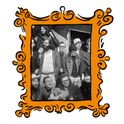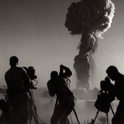I never used to be one for original sources. I don't mean that I would cobble together my history writing from secondary texts and other people's ideas. But the actual texture of the past left me cold. Some researchers get positively feverish at the sight of dusty letters or a crumpled diary from the storeroom of a provincial archive. My own feelings were the exact opposite. All that dust made me sneeze.
I couldn't tell anyone about this aversion to the raw material of my trade. Historians and biographers are supposed to dig deep in their search for authenticity: the point and place where stories begin. That involves getting your hands dirty with material that looks as if it has been lying for decades under Miss Havisham's sideboard. The ancient chest in an attic, which creaks open to reveal a cache of diaries containing a secret that changes everything, is meant to be the historian's primal scene. The fact that the rusty chest is these days more likely to be an archived folder, designated T/P 1930X J2, only slightly spoils the picture. You can still fantasise that you are its first reader, for only you have the combination of knowledge and empathy that enables you to realise the startling significance of the evidence before you.
But when it came to letters and diaries from my own period, the mid-19th century, I was only too delighted if someone had got there first and done an accurate transcription. There could, surely, be no loss of nuance if the spindly handwriting had been methodically translated into typed text, just as long as crossings-out and insertions were dutifully rendered. The document's unruly subtext would not be lost simply because I had not viewed it in its original anarchic form.
This fetishisation of source material as a means of reaching towards a transcendent reality struck me as similar to peasant Catholicism and its credulous worship of holy relics. What next? Tracking down Byron's carriage or Shelley's heart in order to understand Romantic poetry? Fingering Branwell Bront?s beer mug to reach into the dysfunction of that unhappy family? I didn't need to touch the past in order to experience it; I could see it with a kind of inward Protestant sensibility that was all the more powerful for not depending on intermediaries.
Things changed dramatically, however, on the day I acquired some documents all of my own. Two years into researching a biography of Mrs Beeton, the Victorian cookery writer, I got the chance to acquire, in several batches, the letters she had exchanged with her husband-to-be during their year-long engagement. I had no choice: neither the letters nor their transcriptions would be made available to me otherwise. I remortgaged my flat, and bought 50 or so letters written by a very young couple who had no idea that 150 years later their declarations of love, spectacular fallings out and attempts at sounding "literary" would be pored over by a professional historian in her Hackney home.
At first I was frightened of the letters. They were so small and ragged, out of sequence, and had no real beginning or end (the Beetons' relationship had begun prior to the first letter and would continue for nine years after the last). Instead of ordering chaos, as a good transcription will do, they seemed only to drop me further into it. And then there was the worry about keeping them clean. Whereas once I had disliked using original sources because they left me feeling grimy, now here I was wearing ridiculous latex gloves in my own home, looking like a GP about to conduct an internal examination.
Over the next few weeks, I learned to love my own little bit of the past. A mere transcription, I now realise, cannot tell you about the pressure of the pen as it approaches an emotionally tricky bit of prose (Samuel Beeton telling Isabella that she should stand up to her parents, Isabella reminding him please, please not to be late when meeting her train). Nor can it tell you about a postage stamp put on crookedly, or a signature whose swaggering curls suggests either self-confidence or, perhaps, its opposite. In late 1855, Sam Beeton took to sending his love letters in envelopes branded Boy's Own Journal, the magazine he was busy launching. Isabella's stepfather was outraged that such common looking envelopes should arrive at his house. In this little struggle, you see the beginning of a bitter feud that would blight the Beeton marriage. A transcript would not have conveyed to me the brashness of those envelopes, or the offence they caused.
I do not, I should add, now subscribe to the view that you have to meld with the past in order to understand it. "Footstepping"-the practice of following as closely as possible in your subject's wake in order to reconstruct him, perhaps even become him-has never worked for me. I have spent many chilly hours standing in houses, churches, fields and museums trying to force a fellow feeling with my subjects that has stubbornly refused to come. But what I do now, finally, understand is that paying proper attention to the materiality of the past-the way it looks and feels-is much more than an exercise in nostalgia. It is in the nooks and crannies of the historical record that the best stories wait to be discovered.











